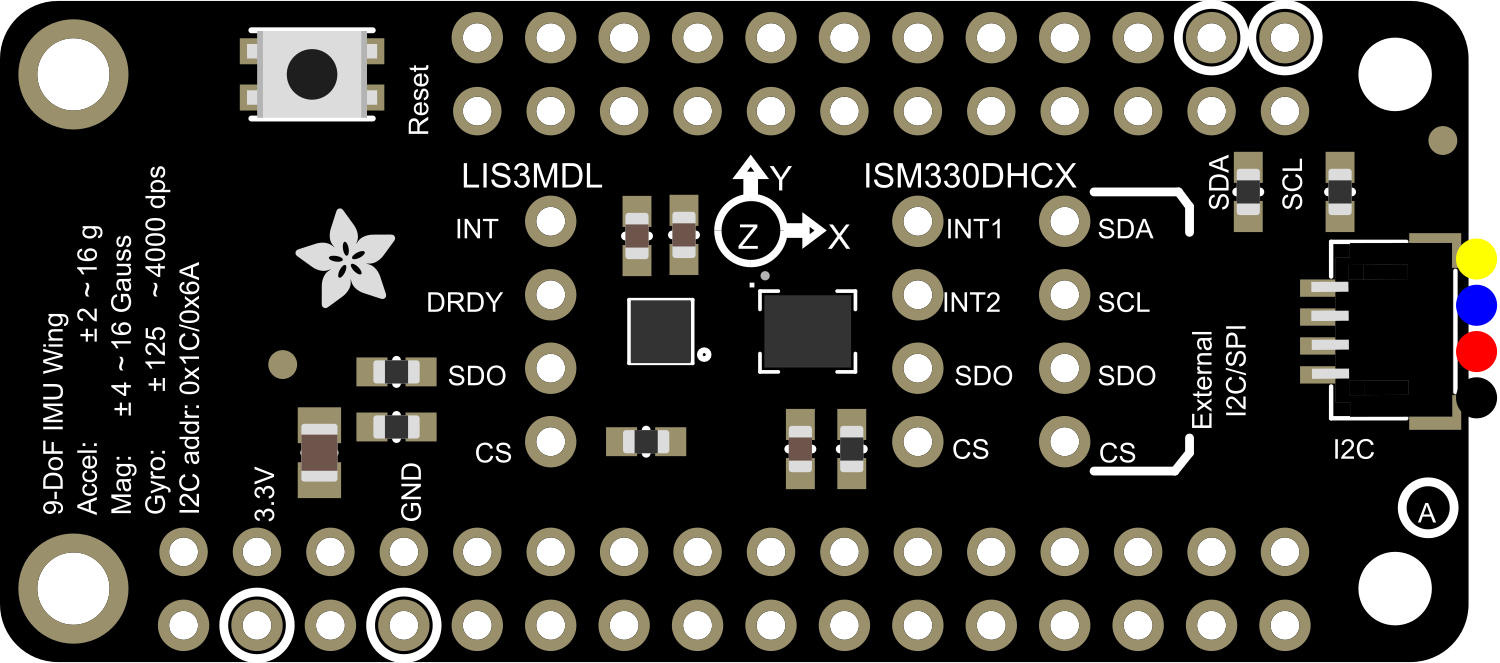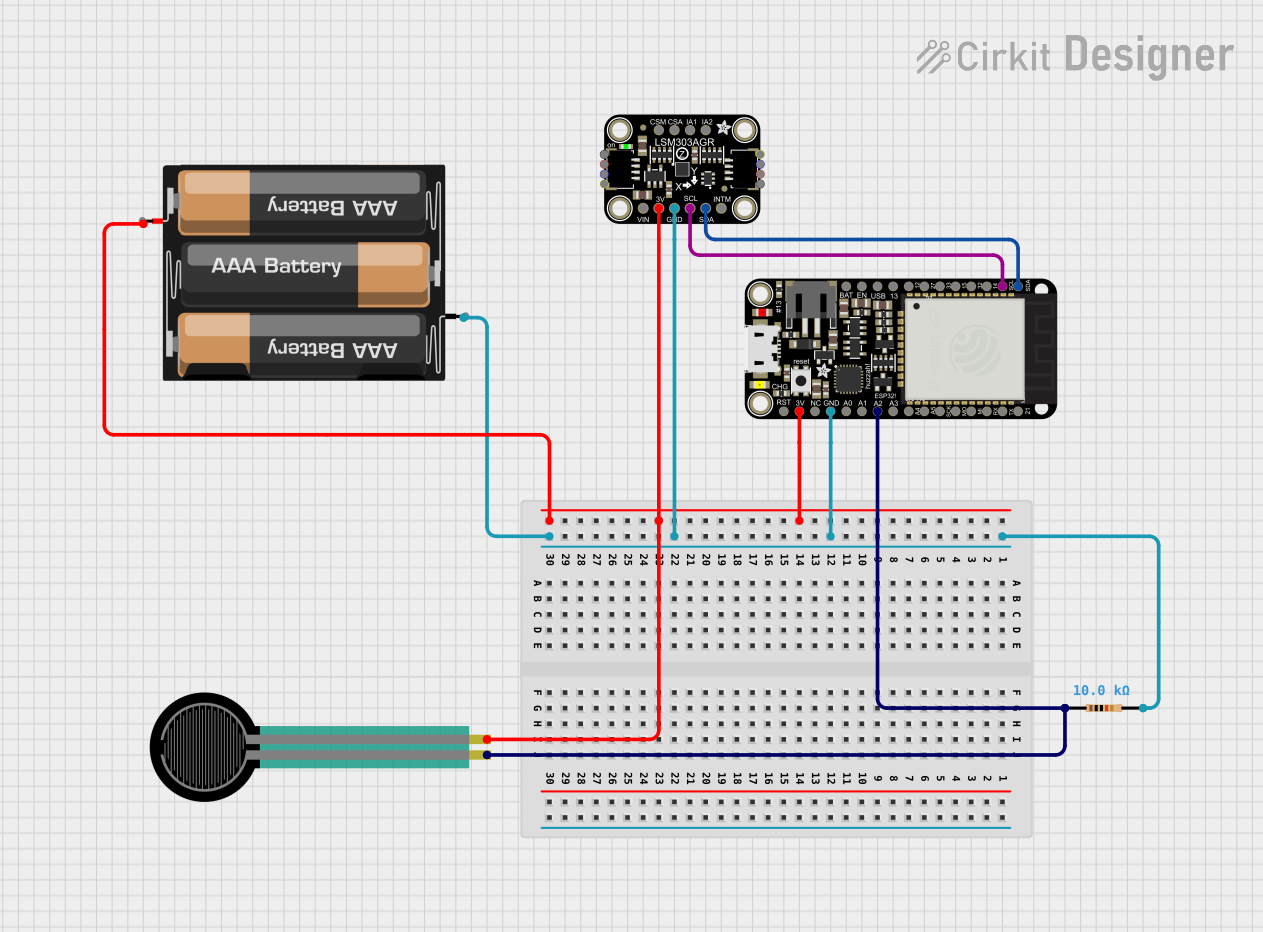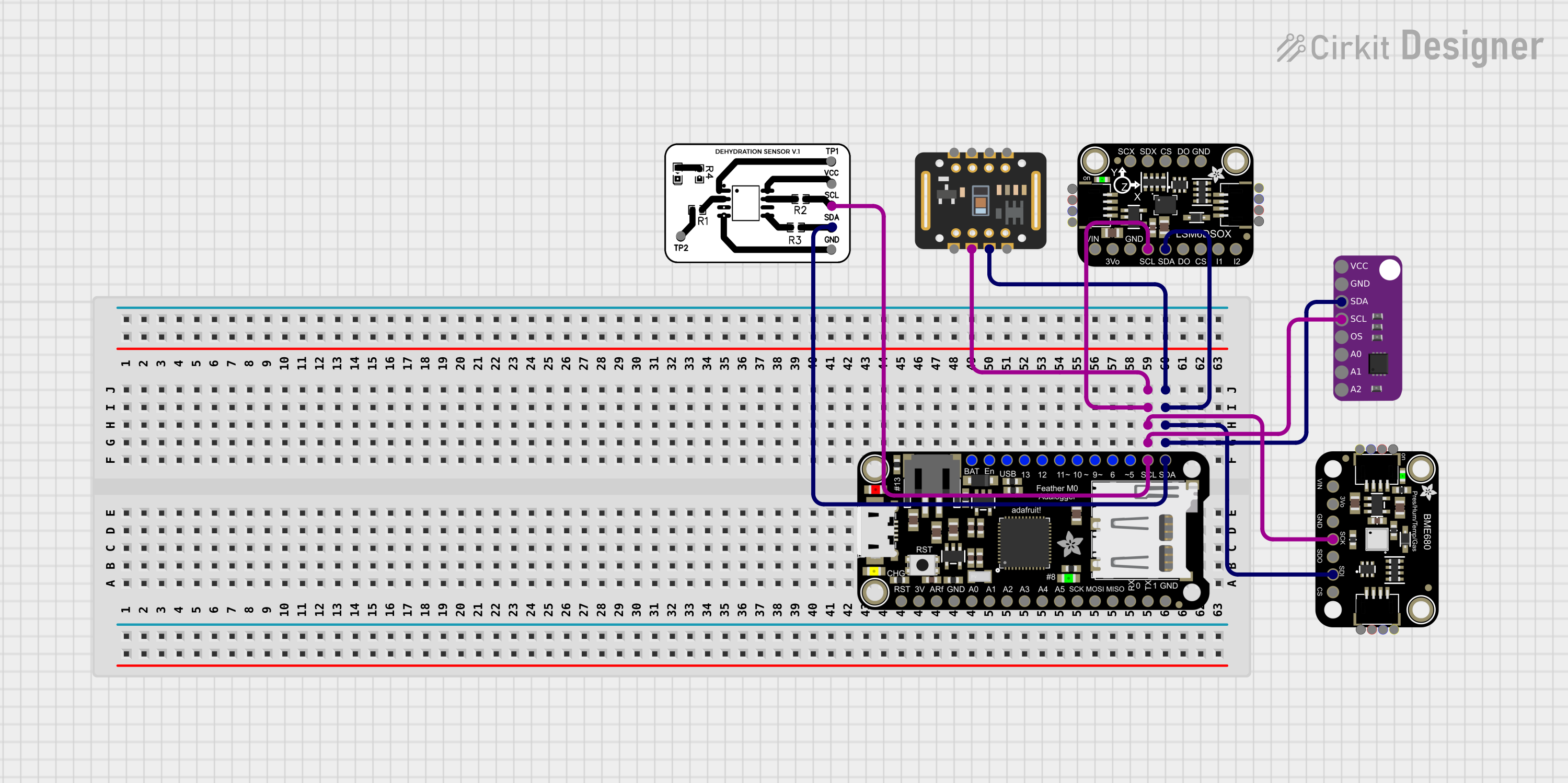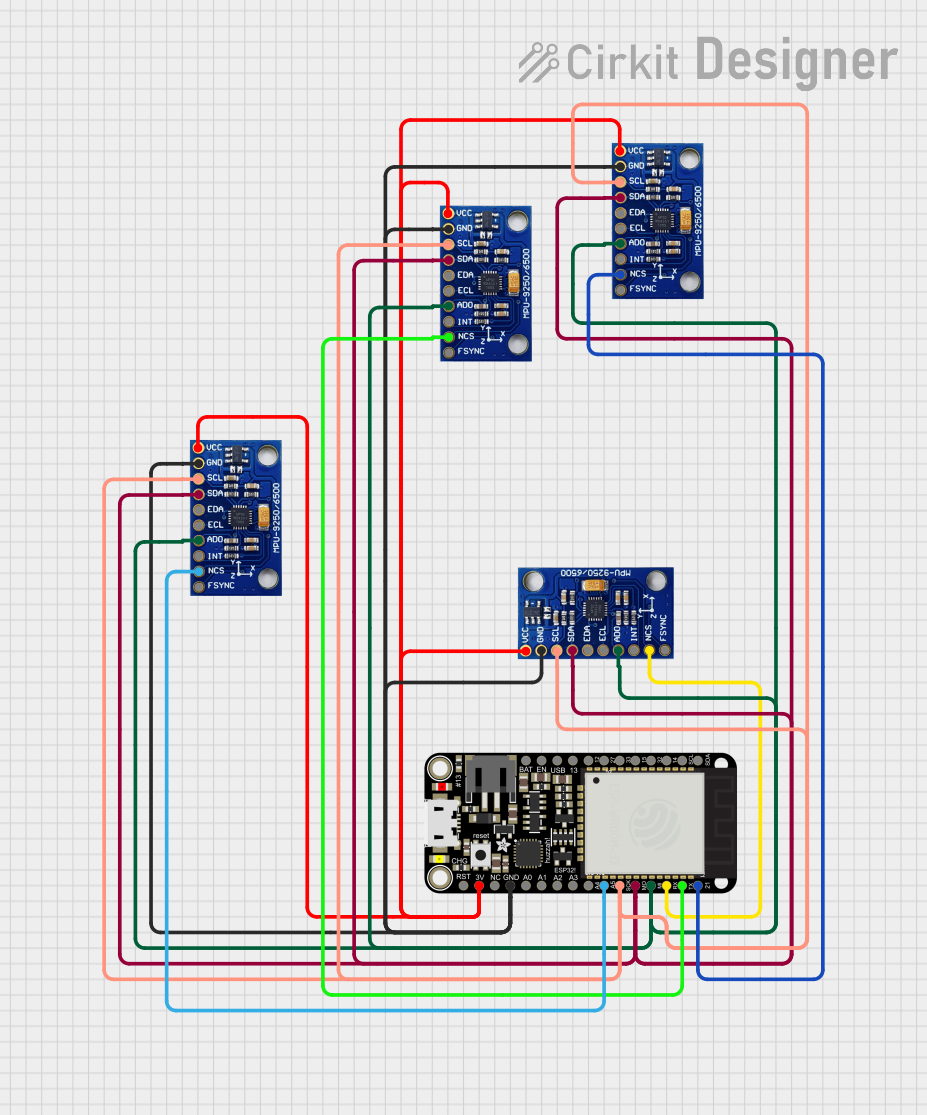
How to Use Adafruit Precision 9-DoF ISM330DHCX + LIS3MDL FeatherWing: Examples, Pinouts, and Specs

 Design with Adafruit Precision 9-DoF ISM330DHCX + LIS3MDL FeatherWing in Cirkit Designer
Design with Adafruit Precision 9-DoF ISM330DHCX + LIS3MDL FeatherWing in Cirkit DesignerIntroduction
The Adafruit Precision 9-DoF ISM330DHCX + LIS3MDL FeatherWing is a comprehensive sensor board designed for motion tracking and orientation sensing. It integrates a 3-axis accelerometer, a 3-axis gyroscope, and a 3-axis magnetometer, providing nine degrees of freedom (9-DoF) for precise motion and orientation data. This makes it an ideal component for applications in robotics, navigation, gesture recognition, and virtual reality, among others.
Explore Projects Built with Adafruit Precision 9-DoF ISM330DHCX + LIS3MDL FeatherWing

 Open Project in Cirkit Designer
Open Project in Cirkit Designer
 Open Project in Cirkit Designer
Open Project in Cirkit Designer
 Open Project in Cirkit Designer
Open Project in Cirkit Designer
 Open Project in Cirkit Designer
Open Project in Cirkit DesignerExplore Projects Built with Adafruit Precision 9-DoF ISM330DHCX + LIS3MDL FeatherWing

 Open Project in Cirkit Designer
Open Project in Cirkit Designer
 Open Project in Cirkit Designer
Open Project in Cirkit Designer
 Open Project in Cirkit Designer
Open Project in Cirkit Designer
 Open Project in Cirkit Designer
Open Project in Cirkit DesignerTechnical Specifications
Key Technical Details
Accelerometer/Gyroscope (ISM330DHCX):
- 3-axis angular rate sensor (gyroscope) with a full-scale range of ±125/±250/±500/±1000/±2000 dps
- 3-axis linear acceleration sensor (accelerometer) with a full-scale range of ±2/±4/±8/±16 g
- Output Data Rates (ODR) from 12.5 Hz to 6.66 kHz
Magnetometer (LIS3MDL):
- 3-axis magnetometer with a full-scale range of ±4/±8/±12/±16 gauss
- Output Data Rate (ODR) up to 155 Hz
Operating Voltage: 3.3V
Interface: I2C
Pin Configuration and Descriptions
| Pin Number | Name | Description |
|---|---|---|
| 1 | SCL | I2C clock line for communication with the microcontroller |
| 2 | SDA | I2C data line for communication with the microcontroller |
| 3 | 3Vo | 3.3V output from the regulator |
| 4 | GND | Ground connection |
| 5 | INT1 | Interrupt output from ISM330DHCX |
| 6 | INTM | Interrupt output from LIS3MDL |
| 7 | RST | Reset line for the sensors |
Usage Instructions
Integration with a Circuit
To use the Adafruit Precision 9-DoF FeatherWing, follow these steps:
- Connect the
SCLandSDApins to the corresponding I2C clock and data lines on your microcontroller. - Connect the
3Vopin to the 3.3V power supply if needed. - Connect the
GNDpin to the ground on your microcontroller. - Optionally, connect the
INT1andINTMpins to available digital pins on your microcontroller if you plan to use interrupt features. - If you need to reset the sensors, connect the
RSTpin to a digital pin on your microcontroller.
Important Considerations and Best Practices
- Ensure that the power supply is 3.3V, as higher voltages can damage the sensors.
- Use pull-up resistors on the I2C lines if your microcontroller does not have built-in pull-ups.
- When placing the sensor in your project, avoid close proximity to magnetic fields or metals that can distort the magnetometer readings.
- For accurate readings, calibrate the magnetometer in your final installation environment.
Example Code for Arduino UNO
#include <Wire.h>
#include <Adafruit_Sensor.h>
#include <Adafruit_LSM6DS33.h>
#include <Adafruit_LIS3MDL.h>
// Create sensor instances
Adafruit_LSM6DS33 lsm6ds33;
Adafruit_LIS3MDL lis3mdl;
void setup() {
Serial.begin(115200);
// Initialize the sensors
if (!lsm6ds33.begin_I2C()) {
Serial.println("Failed to find LSM6DS33 chip");
while (1) {
delay(10);
}
}
if (!lis3mdl.begin_I2C()) {
Serial.println("Failed to find LIS3MDL chip");
while (1) {
delay(10);
}
}
}
void loop() {
// Read the accelerometer and gyroscope
sensors_event_t accel;
sensors_event_t gyro;
sensors_event_t mag;
lsm6ds33.getEvent(&accel, &gyro, NULL);
lis3mdl.getEvent(&mag);
// Print the values to the Serial Monitor
Serial.print("Accel X: "); Serial.print(accel.acceleration.x); Serial.print(" m/s^2 ");
Serial.print("Gyro X: "); Serial.print(gyro.gyro.x); Serial.print(" rad/s ");
Serial.print("Mag X: "); Serial.print(mag.magnetic.x); Serial.println(" uT ");
// Add a delay between reads for stability
delay(100);
}
Troubleshooting and FAQs
Common Issues
- Sensor not detected: Ensure that the wiring is correct and that the I2C address is not conflicting with other devices on the bus.
- Inaccurate readings: Calibrate the sensors, especially the magnetometer, and ensure there are no magnetic interferences nearby.
- No data from the sensor: Check the power supply and connections. Ensure that the microcontroller's I2C library is properly initialized.
Solutions and Tips for Troubleshooting
- Double-check the wiring and soldering for any loose connections or shorts.
- Use the I2C scanner sketch to confirm the presence of the device on the I2C bus.
- Reset the sensor using the
RSTpin if the sensor is unresponsive. - Consult the Adafruit forums and community for help if you encounter persistent issues.
FAQs
Q: Can I use this FeatherWing with a 5V microcontroller? A: Yes, but ensure that the logic levels are shifted to 3.3V to avoid damaging the sensors.
Q: How do I calibrate the magnetometer? A: Adafruit provides a calibration sketch and guide on their website. Follow the instructions to calibrate the magnetometer for accurate readings.
Q: What is the I2C address of the sensors? A: The ISM330DHCX default I2C address is 0x6B, and the LIS3MDL default I2C address is 0x1E. Make sure these addresses are not used by other I2C devices in your project.